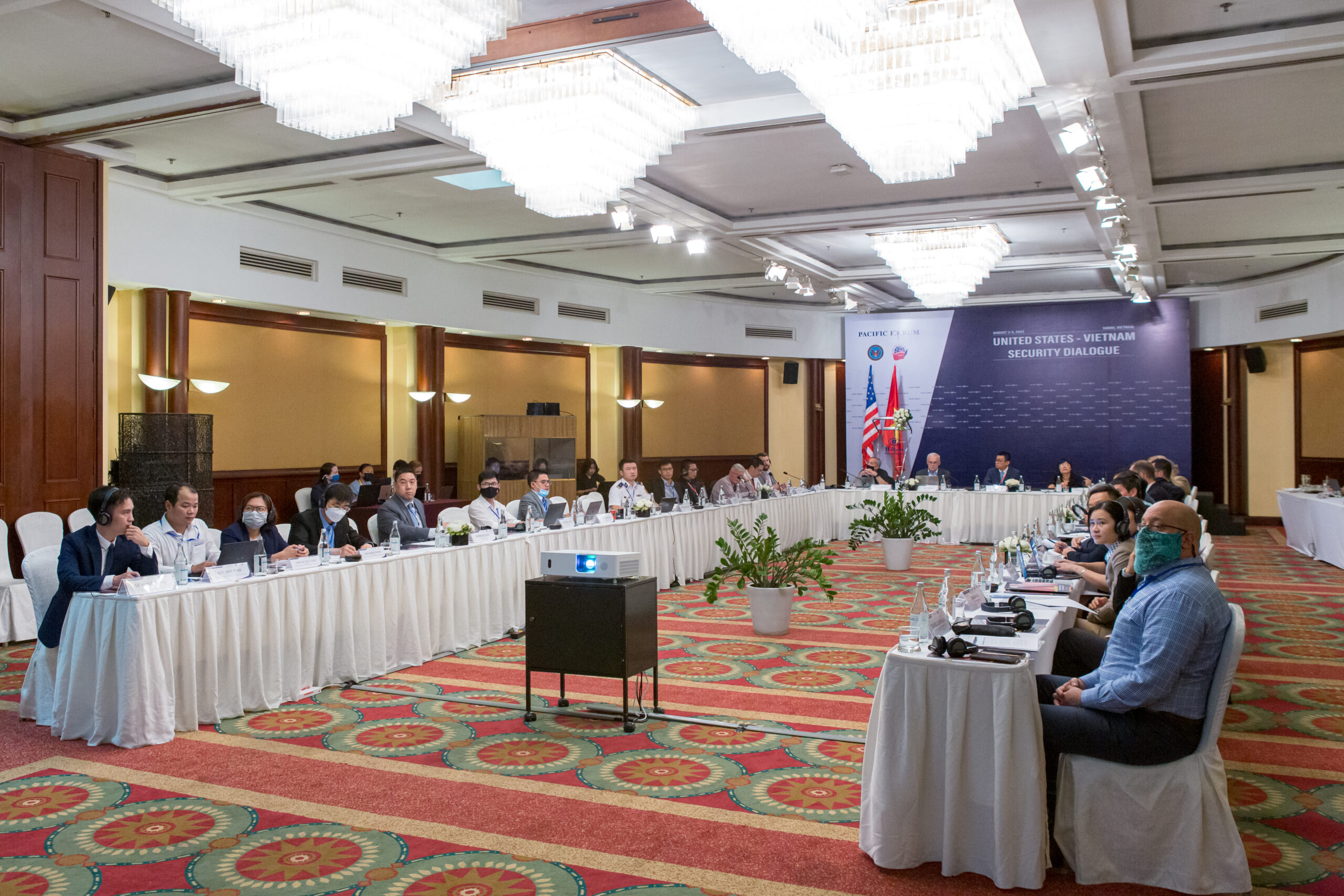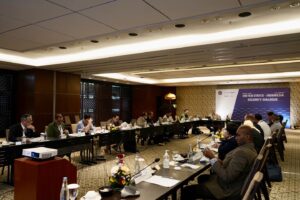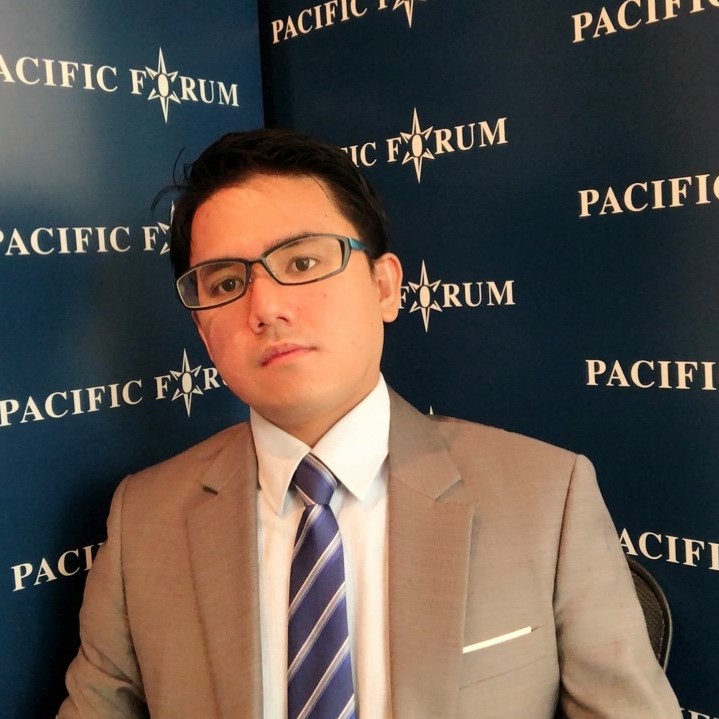Executive Summary
INTRODUCTION
Pacific Forum reconvened two Track 2 dialogues with Vietnam and Indonesia in August 2022 to help identify ways the United States and its two Southeast Asian partners can work together to enhance bilateral cooperation on security issues of shared concern. Functional cooperation between Washington and its two Southeast Asian partners has considerably advanced in the past ten years, but differing strategic considerations still handicap some aspects of these relationships. The two security dialogues emphasized these findings, among other takeaways.
FINDINGS SUMMARY
In its February 2022 Indo-Pacific Strategy document, the United States stressed that “collective efforts over the next decade will determine whether the PRC succeeds in transforming the rules and norms that have benefitted the Indo-Pacific and the world.” The 2021 U.S.-Vietnam and U.S.-Indonesia security dialogues had made clear that such framing would not generate broad Southeast Asian cooperation. This year’s dialogues echoed similar themes while underscoring functional cooperation as vital to the two countries’ security relations with the United States. Their strategic autonomy and agency are central to their response to threats from Beijing, and they are reluctant to align outright with the United States on China-related strategic considerations. Nevertheless, Indonesia and Vietnam are interested in working with the United States when it strengthens their strategic autonomy and ability to stand up to threats, including those from China. Two interconnected factors determine Indonesian and Vietnamese strategic thinking regarding China’s assertive behavior and willingness to cooperate with the United States on security issues. First, geography makes China an everyday presence for Hanoi and Jakarta and their economies. Second, the self-help regional security environment compels Jakarta and Hanoi to be extra cautious in dealing with Chinese assertiveness. They are not U.S. treaty-allies. Vietnamese and Indonesian interlocutors do not expect the United States to defend Vietnam and Indonesia should Beijing use force.
KEY FINDINGS AND RECOMMENDATIONS FROM THE TWO SECURITY DIALOGUES
Finding: China has specifically designed its operations in the South China Sea to avoid thresholds for escalation and response by using civilian or non-military actors to operationalize claims using tactics that fall short of kinetic armed conflict. China would perceive any response to a gray zone coercion either as “escalatory”—possibly provoking a stronger Chinese response that could result in a complete reversal of status quo of certain features—or “muted”—which could encourage Beijing to attempt more coercive maneuvers.
- Recommendation: The United States and its partners must challenge the narrative surrounding the existence of civilian and non-military actors in the South China Sea. First, Washington should support regional partners’ efforts to identify, document, and publicize militia operations, including publishing photos and videos in open source, disseminating evidence in Track 1 forums and venues like the Association of Southeast Asian Nations (ASEAN) Defense Ministers Meeting Plus and the International Maritime Organization (IMO). Second, Washington must link the behavior of China’s maritime militia and Coast Guard to its interactions with the PLAN. The United States should communicate publicly and privately that it expects the PLAN, the Coast Guard, and the maritime militia to abide by the internationally recognized standards of seamanship and communications, including the Code for Unplanned Encounters at Sea (CUES).
- Recommendation: Washington should take three actions to address the gradual, non-kinetic nature of China’s gray zone tactics. First, it should help improve situational awareness through capacity-building efforts that enhance partners’ maritime domain awareness, such as through provisions of maritime Intelligence, Surveillance, Reconnaissance (ISR) capabilities, including remote sensing tools, unmanned platforms, and coastal radar. Second, it should help address the asymmetry in capabilities by tailoring defense assistance to partners with more surface assets to maintain sustained presence and expanding maritime law enforcement capabilities through initiatives like Coast Guard ship-riding programs. Finally, the United States and its partners should thoroughly discuss potential non-kinetic tactical responses to harassment.
- Recommendation: The United States should establish a task force within the Seventh Fleet, modeled on Task Force 59 in the Fifth Fleet, to develop and deploy unmanned and automated maritime domain awareness platforms in coordination with Vietnam and other regional partners. This could vastly improve the ability to monitor and identify Chinese gray zone actors in a persistent and affordable manner.
Finding: U.S. efforts at direct deterrence (e.g., U.S. Navy operations to defend its own freedom of navigation) in the South China Sea have been much more successful than extended deterrence (e.g., assisting Vietnam and other coastal states in the region to protect their own maritime rights and interests against Chinese coercion).
- Recommendation: The United States should reinforce the principle of freedom of navigation in the South China Sea by clearly articulating through official documents and in meetings with China that the use of force to deny U.S. civilian or military vessels from rightful access to the South China Sea is a red line for the United States.
- Recommendation: The United States should articulate through official documents and in meetings with regional states that changing the status quo of disputed features by using force or gray zone coercion (e.g., ejecting existing Vietnamese presence on a disputed land feature) is another U.S. red line. The United States should engage its regional partners to establish acceptable parameters for a combined response and then respond appropriately in coordination with partner countries.
Finding: In a gray zone maritime crisis involving China, Vietnam will simultaneously de-escalate by engaging Beijing and defend its interests by deploying non-military assets to assert presence or control. Coordinating with Washington to address a China-related gray zone crisis would not be a top priority for Hanoi. Meanwhile, Indonesia will resolutely respond to a gray zone crisis by safeguarding its interests and preventing a fait accompli while maintaining its strategic autonomy. Jakarta will use its diplomatic, military, and paramilitary assets to maintain the status quo. The Indonesians would prefer the United States carefully balance its engagement and avoid direct involvement in any Indonesia-China tension. Both Hanoi and Jakarta expect that their strategic space to de-escalate or arrive at an acceptable solution would be severely constrained once the United States is directly involved, and the crisis would be reframed in the context of “great power competition.”
- Recommendation: Addressing a gray zone crisis requires coordination between Washington and the partner country directly involved. In this regard, the United States should immediately consult with partner countries about the best course of action before making any move.
Finding: Beijing is unlikely to use outright aggression against Southeast Asian states. Instead, China will continue to push the envelope in the South China Sea and elsewhere through gray zone/non-kinetic means. Absent any effective response, Beijing will achieve more fait accomplis, which are extremely difficult to roll back without the use of force.
- Recommendation: The United States should continue to devote more resources (e.g., by sponsoring more tabletop exercises, research, and dialogues) to better understand China’s use of gray zone coercion and draft plans accordingly. The United States should also discuss potential responses to counter gray zone coercion with partners and allies.
KEY FINDINGS AND RECOMMENDATIONS FROM THE U.S.-VIETNAM SECURITY DIALOGUES
Finding: Vietnam’s policy documents regard defense cooperation, including joint exercises, with other countries as important “to improve capabilities to protect the country and address common security challenges.” However, Vietnam makes a distinction between military exercises that are aimed at developing war-fighting skills (tập trận) and military training exercises to learn or improve basic skills (diễn tập). Vietnam will not participate in the former with the United States, which could potentially explain Hanoi’s lack of interest in joining the Rim of the Pacific (RIMPAC) exercise.
- Recommendation: When the United States invites Vietnam to join a bilateral or multilateral exercise, Washington should clarify that the purpose is to improve basic skills (diễn tập). In bigger exercises like the RIMPAC, U.S. invitation extended to Hanoi should stress the diễn tập value of the activities.
Finding: The United States sees Hanoi as a stabilizing force in the region. Vietnam has shown determination to continue the trajectory of its military modernization, which could present opportunities for the United States, not just in providing hardware, but also in deepening institutional ties, interoperability, and long-term trust. In 2021, Vietnam committed to “building a streamlined and strong Army by 2025, and a revolutionary, regular, highly-skilled and modern People’s Army by 2030,” vowing to prioritize Air Defense/Air Force Service, Navy, Signal Force, Electronic Warfare Force, Technical Reconnaissance Force, Cyber Warfare Force, and Cipher (cryptology) Force.
- Recommendation: Washington could offer to help Hanoi realize some of the aspects of its 2030 military modernization plan, for example, by building on the successful U.S.-Vietnam deal for the transfer of three T-6 trainers by 2023, along with spare parts and a maintenance package. The U.S. should continue to probe Vietnamese willingness to purchase more T-6s with a package including simulators, maintenance, and participation in an expanded aviation leadership program. This could provide the basis for Vietnam to acquire more advanced fighter jets in the future. Helping modernize Vietnam’s military capabilities could promote mutual trust, which in turn could result in deeper bilateral cooperation. It could also help Hanoi secure its maritime zones amidst Chinese coercion and contribute to regional security free from Chinese dominance.
Finding: Vietnam is unlikely to reinvigorate its civilian nuclear power program in the near future. Despite the high expectations surrounding the advent of Small Modular Reactors (SMRs), interest in Vietnam is still not enough to push policymakers to reconsider a 2016 decision to halt Vietnam’s pursuit of nuclear energy. The view remains that Vietnam and Southeast Asia broadly have considerable alternatives to nuclear power. Nevertheless, Vietnamese experts stressed that SMRs and floating nuclear power plants are important topics for research, but any development is beyond the 10-year horizon.
- Recommendation: The U.S. Government should provide educational opportunities for Vietnamese nuclear engineers and nuclear policy/security experts. This would ensure that U.S.-educated engineers and experts are readily available should Hanoi decide to restart its civil nuclear program. This would counter potential Chinese or Russian influence in determining the trajectory of Vietnam’s nuclear energy policy.
Finding: The U.S. and Vietnamese responses to the Itu Aba exercise conducted at the U.S. Vietnam Track 2 dialogue revealed the undercurrents in U.S. and Southeast Asian strategic thinking. First, Washington would not go to war against China to defend partner countries over small offshore territories in the South China Sea. Second, Southeast Asians’ primary consideration when dealing with Chinese provocation is the idea that when hostilities escalate, they are on their own. U.S. partners do not expect the U.S. military to fight for them should there be a conflict.
- Recommendation: capacity-building initiatives should focus on helping partner countries obtain capabilities that allow them to maintain an active, sustained and visible presence in their own maritime zones. This means providing partner countries with surface assets like law enforcement patrol vessels that are capable of navigating their vast exclusive economic zones for longer periods and with the capacity to respond to Chinese coercion.

KEY FINDINGS AND RECOMMENDATIONS FROM THE U.S.-INDONESIA SECURITY DIALOGUES
Finding: Disagreement related to Archipelagic Sea-Lane (ASL) passage could become a long-term operational issue between Indonesia and the United States. The United States wants Indonesia to allow all navigational rights and freedoms within its archipelago as described in the United Nations Convention on the Law of the Sea (UNCLOS). Indonesia, however, remains reluctant to introduce more archipelagic sea-lanes, fearing the presence of more foreign warships in its archipelagic waters.
- Recommendation: The United States should have regular, standalone maritime security dialogues with Indonesia at the Track 1 and Track 2 levels to understand the factors that inhibit Indonesia from fully complying with the ASL provisions of the UNCLOS and help reassure Jakarta that U.S. military operations fully respect Indonesian sovereignty and territorial integrity. On the former, Indonesia’s lack of maritime domain awareness may be discouraging it from establishing additional ASLs, in which case the United States could be helpful. On the latter, regular interactions between Indonesian and U.S. maritime institutions and experts would increase trust over time, which could lead to more maritime cooperation that accommodates both U.S. preferences and Indonesian interests.
Finding: Indonesia’s growing Anti-Access/Area Denial (A2/AD) capabilities, while not targeted at any specific country, could complicate assumptions about force flows, supply chains, and ally reinforcements. In this context, Indonesia could potentially close off its waters from all military forces, including the United States and its treaty allies, in the event of a crisis, for example, over Taiwan.
- Recommendation: U.S. military planning should take into account access to Southeast Asian territorial seas, and archipelagic waters (including their airspaces) to assess the impact of potential restrictions or differing interpretations of international maritime law.
- Recommendation: More U.S. Government-sponsored dialogues and tabletop exercises should include Indonesia and other important partner countries in Southeast Asia to help promote common understanding and appreciation of key issues that arise during crises.
Finding: Two U.S.-led frameworks, the Global Initiative to Combat Nuclear Terrorism (GICNT) and the Proliferation Security Initiative (PSI), could assist Indonesia with its Counterterrorism and Counterproliferation capacity-building. Neither the GICNT nor the PSI creates new obligations for participating states. Instead, cooperation is voluntary, with individual members’ respective national authorities coordinating to help ensure that bad actors, including extremists, do not obtain Weapons of Mass Destruction (WMD)-related materials. Indonesia’s persistent refusal to join U.S.-led security institutions is a political decision, rather than an objection to their operating principles.
- Recommendation: Washington should clearly articulate in Track 1 dialogues involving policymakers that both GICNT and PSI would allow Indonesia to remain carefully protective of its own national sovereignty and independence. The United States should also underscore the multilateral nature of these arrangements.

About this report
Pacific Forum, in collaboration with local partners, the Diplomatic Academy of Vietnam (DAV), and the Foreign Policy Community of Indonesia (FPCI), organized the Track 2 U.S.-Vietnam and U.S.-Indonesia Security Dialogues in August 2022. With support from the Defense Threat Reduction Agency (DTRA), ten U.S. strategic thinkers, including scholars, policy experts, and retired military and government officials, traveled to Hanoi on August 3-5, 2022, and to Bali on August 9-11, 2022, to meet and engage with 19 counterparts from Vietnam and 14 from Indonesia. Both Track 2 dialogues included one day of panel discussion on thematic issues and one day devoted to a scenario-based exercise. The recommendations contained in this report, unless otherwise specifically noted, were generated by the discussions as interpreted by the Principal Investigators. This is not a consensus document. Both the agenda and participant list are included in the appendix; all participants attended in their private capacity. The statements made and views expressed in this publication do not necessarily reflect the views of the Pacific Forum, the project sponsors, or the dialogue participants’ respective organizations and affiliations. For questions, please email [email protected].
Click here to download the full report.









